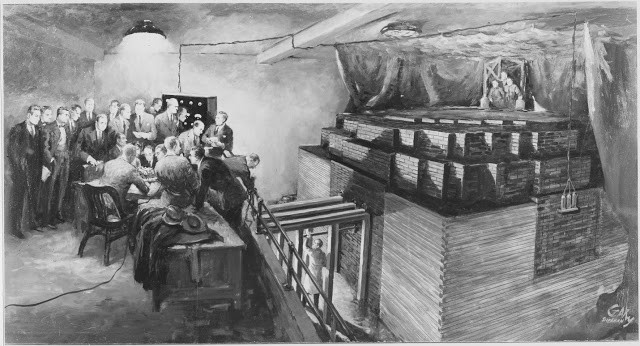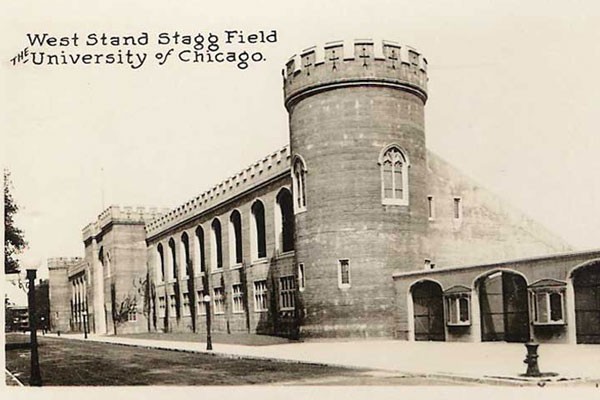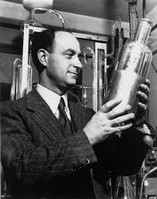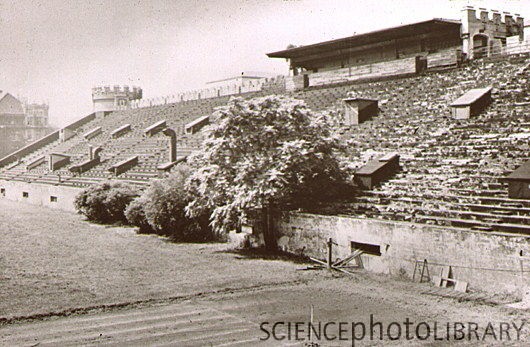Stagg Field and the first controlled nuclear reaction, 1942
Introduction
Text-to-speech Audio
Images
Chicago Pile Number One

West Stand, Stagg Field, Chicago, IL

Enrico Fermi

Physicist Enrico Fermi and his colleagues established the first self-sustaining controlled nuclear reaction in makeshift laboratories constructed under the grandstands of Stagg Field on December 2, 1942.

Backstory and Context
Text-to-speech Audio
Italian born scientist Enrico Fermi had worked with uranium for years. Having received the Nobel Prize in 1938 for his work on transuranic elements, and later moving to America, he was the lead scientist at the University of Chicago during the secretive Manhattan Project efforts. In 1939 it was discovered that bombarding an atom of uranium with neutrons would sometimes cause the uranium atoms to split. Later scientists discovered that when the uranium atom split, additional neutrons would emit and present the possibility of further reaction with other atoms. Knowing this, scientists deduced that a chain reaction was quite possible under this fission process. It was further believed that with enough uranium compiled together under the right circumstance, a controlled chain reaction could occur, at a point known as the “critical mass”. Over the next three years this concept was studied but it wasn’t until almost a year after the bombing of Pearl Harbor in 1941 a pile of critical mass was constructed and the controlled nuclear chain reaction had become reality.
During Fermi’s research, the squash court turned nuclear laboratory, had an odd look. Centered in a 30’ by 60’ room and covered on three sides by a gray balloon cloth laid a pile of bricks and wooden timbers. With square sides on the bottom and flat part way up the sides, a dome shaped top completed the careless “pile” look, a word now used to describe these devices. The scientists joked amongst themselves at this sight saying “If people could see what we’re doing with a million-and-a-half of their dollars, they’d think we are crazy. If they knew why we are doing it, they’d know we are.” (atomicarchive.com) Fermi and the other scientists stacked 19,000 pieces of uranium metal, uranium oxide fuel and 40,000 graphite blocks within a 24 foot square wooden frame to build Chicago Pile Number One (CP-1).
Scientist George Weil pulled out the cadmium-plated control rod at the critical mass point and history was made. After the success of this first controlled nuclear reaction more allocated funds poured into the project and nuclear facilities were being built in Tennessee and Washington. The Manhattan Project was about to experience rapid growth and top secret priority. By July 16, 1945 the first atomic bomb was ready to be tested. Members of the Manhattan Project were at the Alamogordo, New Mexico site to experience its detonation. After a blinding flash, a mushroom cloud that had reached 40,000 feet into the sky returned to earth, creating a half-mile wide crater. The scientists and government knew that a new age of weaponry was upon us.
Although destructive in the form of a bomb, the nuclear age brought upon many attributes as well. In the 1950’s the Atomic Energy Commission funded the opening of the Argonne Cancer Research Hospital and developed a treatment for cancer known as radiation. Expanding on this development, the continued use of radiological innovations enables the ability to diagnose and treat other types of diseases.
